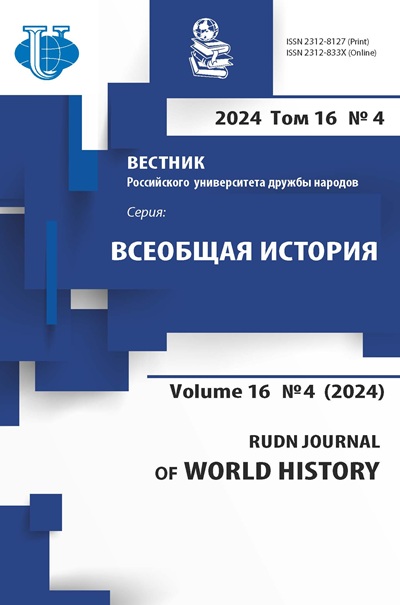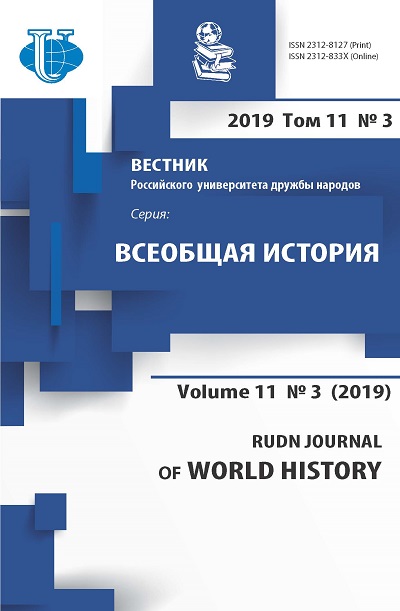Vol 11, No 3 (2019)
- Year: 2019
- Articles: 9
- URL: https://journals.rudn.ru/world-history/issue/view/1306
- DOI: https://doi.org/10.22363/2312-8127-2019-11-3
Full Issue
Discussions
The phenomenon of «man between life and death» in the space of the Nazi concentration camp
Abstract
The article explores the phenomenology of a special category of prisoners of Nazi concentration camps, who were in a state close to death, but for a long time did not die, being in a special, borderline state of mind and body. In camp jargon, they were called “Muslims”, which was not related to religious confession - the etymology of the term is controversial. The state in which the “Muslims” were, is an unknown phenomenon, since it is characterized by almost complete fading of mental and physical functions, the Erasure of age and sex characteristics. This category of prisoners can be considered the apotheosis of the Nazi concentration camp system.
 195-201
195-201
 603
603
Oriental Studies
Some aspects of regent titles in Tibet (XVII-XVIII)
Abstract
Historical sources provide variety of Tibetan and Mongolian terms that were related to the position of regent in the Tibetan government of the XVII-XVIII centuries: desrid, deba, gyaltsab, gyalpo, miwang, nominhan and others. Probably, such a variety is associated not only with the constant changes of regent role and functions in some periods of Tibetan history, but also with the specifics of the relationship between politics and religion in a Buddhist state, as well as with the influence of Qing Empire. An analysis of the listed items in the context of the Tibetan system of government will allow classifying them by meaning and historical periods, to identify differences from the classical European concept of “regent”. It also helps to study some details of the regency history in Tibet, which has only few researches at the moment.
 202-212
202-212
 899
899
Display of Zen principles on distinctive features of Japanese business culture
Abstract
The aim of the research is to determine peculiarities of Japanese business culture, which formation and development was resulted from the influence of Zen Buddhism. The relevance of issue stems from the fact that in the context of globalization it is necessary to understand cultural specificities of business cultures in order to improve and adapt them to the constantly changing business environments. The main hypothesis to be confirmed is that core principles and values of modern Japanese companies’ practices to a great extent have been developed in the context of Zen, that served as a principle guideline of monks’ and samurai’ economic operations several centuries prior. The hypothesis will be proved through mixed methodology with the implementation of descriptive, historical and comparative analysis.
 213-221
213-221
 1446
1446
The evolutionary process of normalization of Soviet-Chinese relations and its historical significance
Abstract
The normalization of Sino-Soviet relations reflects the gradual release of China’s foreign policy from the framework of strategic thinking that emerged during the Cold War and reflects a new diplomatic concept that has developed and enriched by Chinese leaders in the course of openness reforms. After almost three decades, the Chinese leaders finally advanced the “Social Path with Chinese Characteristics” and chose the “Independent Peaceful Foreign Policy”, which marks the implementation of radical coordination between China’s national development strategy and foreign policy since the late 1950s, marking the end of the cold war. The normalization of Sino-Soviet relations had an important influence not only on the entire process of the Cold War, but also on the social and political processes in China, in the first place. The process of development of Soviet-Chinese and Russian-Chinese relations directly reflects the establishment and regulation of domestic and foreign policy after the founding of New China, which has a great influence on the international political arena.
 222-234
222-234
 729
729
Display of Zen principles on distinctive features of Japanese business culture
Abstract
The aim of the research is to determine peculiarities of Japanese business culture, which formation and development was resulted from the influence of Zen Buddhism. The relevance of issue stems from the fact that in the context of globalization it is necessary to understand cultural specificities of business cultures in order to improve and adapt them to the constantly changing business environments. The main hypothesis to be confirmed is that core principles and values of modern Japanese companies’ practices to a great extent have been developed in the context of Zen, that served as a principle guideline of monks’ and samurai’ economic operations several centuries prior. The hypothesis will be proved through mixed methodology with the implementation of descriptive, historical and comparative analysis.
 901
901
HISTORIOGRAPHICAL STUDY
Holy Union in modern Russian historiography
Abstract
The article analyzes the research of modern Russian historians on the problems associated with the emergence, activity and significance of the Holy Union as an interstate Association of the first half of the XIX century. The study, analysis and evaluation of the Holy Union were engaged in scientists and pre-revolutionary and Soviet periods. But their conclusions were largely determined by the political and ideological features of the two periods of the Russian state. The modern Russian historiography of the Holy Union is characterized by the rejection of both the assessments of historians of tsarist Russia praising Imperial decisions and those explaining the activities of the Holy Union from the reactionary positions of historians of the Soviet period. At the present stage of Russian historical science, due to the absence of ideological restrictions and the involvement of a wide range of archival sources, scientists continue to study the Holy Alliance as an integral part of the Vienna system of international relations of the first half of the XIX century, and as an independent Association of European States. At the same time, in the works of Russian scientists, the Holy Union is considered and evaluated the personal and religious factors of this organization.
 235-246
235-246
 1137
1137
“The Crimean war in the collective memory”: modern Western European historiography of the Crimean campaign of 1853-1856
Abstract
The article analyzes the modern Western historiography of the Crimean war of 1853-1856. The authors refer to problems and issues that prevail in the French and British studies of the events of 1853-1856. In the Western historiographical tradition based on researches of the XIX-XX centuries, still remain insufficiently explored aspects of the Crimean war, for example, the siege of Sevastopol, military operations in the Baltic and White seas, in the Pacific ocean, in the Caucasus. Despite the obvious trend existing in modern European science, associated with the study of the Crimean campaign in the context of the first pan-European war, the attention of historians of Western Europe is more focused on the study of the First world war. However, in recent years there has been a clear interest of French, English and Italian authors to the Black sea region, to the history of the Crimea and, as a consequence, to the Crimean campaign. Generalization of modern experience of historiography of the Crimean war allows to define prospects for further researches.
 247-255
247-255
 1053
1053
Archaeological studies
Hand-made ceramics on the territory of Murzaly in the Eastern Aral Sea region
Abstract
The article is devoted to the study of medieval hand-made ceramics of the settlement of Murzaly in the territory of the Eastern Aral sea region. The features of its manufacturing technology, forms, ornamentation are highlighted, a comparative typology is carried out. The coarse hand-made ceramics of the Murzaly settlement has a kitchen purpose. It is represented by boilers, pots, jugs, cans, bowls and lids. The studied ceramics does not find analogies in the complexes of the developed Central Asian states. It probably could have been formed on the territory of the Eastern Priaralye and was associated with the migrations of nomadic and semi-nomadic tribes. The fact of the discovery of coarse hand-made ceramics in the settlement Murzaly confirms the assumption that it could have been the wintering ground of medieval nomads of the 10th-11th centuries.
 256-266
256-266
 479
479
History of Europe
Image of doctor of Italy in the XIV century through the eyes of a contemporary (based on the example of “Invectives against a doctor” by Francesco Petrarch)
Abstract
This article presents an attempt to reconstruct the image of doctor and the state of medicine in Italy in the XIV century. The work has an interdisciplinary character, is based on the traditions of the social and cultural history of medicine. The main source is Francesco Petrarch’s essay “Invectives against a doctor” (the mid-XIV century). The study of the main source, which is a subjective reflection of the processes and phenomena of that time, is supplemented by a careful study of the cultural and historical component, the picture of the world at that time. The author concludes that Petrarch, a representative of the Renaissance worldview, uses medieval methods of appealing to authorities. In order to create a voluminous reconstruction, it becomes necessary to study the medieval worldview (Le Goff J., Truon N.). Significant attention is paid to the disclosure of such issues as the place of a symbol, hierarchy, words in the culture of that time. Such components of the picture of the world as corporatism, attitude to virtue and sin, manual labor, authorities, science, art and medicine are involved. Negative components of the image of doctor and medicine of Italy in the XIV century, as evidenced by Petrarch, are supplemented with an alleged positive or ideal component, which results in a volumetric characteristic of the issue.
 267-276
267-276
 670
670














